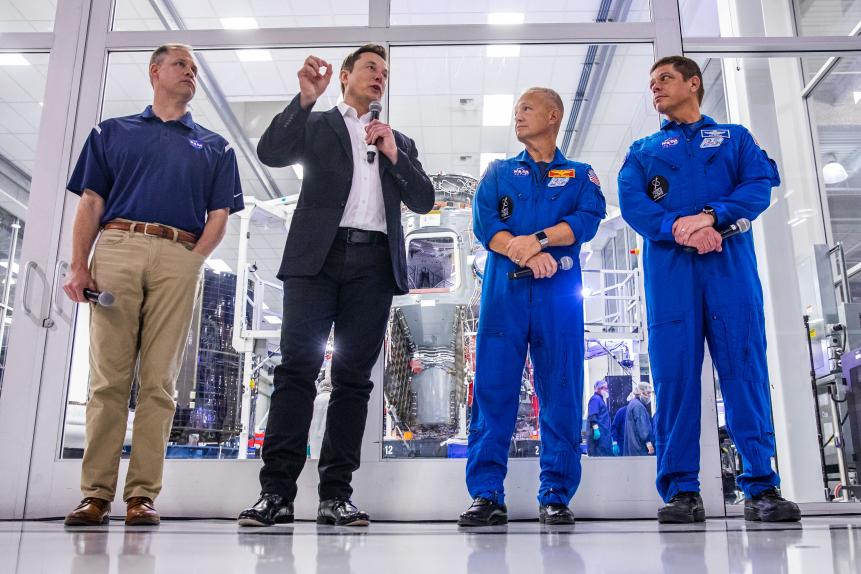
Julie Andrews / 500px
What Could Delay the Historic SpaceX and NASA Launch?

Detailed planning and test after test do not always mean smooth sailing in space flight.
Everybody who’s anybody is waiting with gleeful anticipation for May 27th. If all goes as planned, a rocket will carry two astronauts to the International Space Station, launching from Cape Canaveral. This would be the first crewed launch from American soil since the retirement of the Space Shuttle in 2011. And an added bonus: the rocket and capsule were designed and built by the private spaceflight company SpaceX, another first. Sweet.
But like I said, if all goes as planned.
SpaceX and NASA have already performed so many tests that “a lot” seems inadequate. The joint efforts of the private company and the space agency are about as ready as they can possibly be: testing individual components over and over, checking integrations to an overwhelming degree, and performing uncrewed (as in, empty) test launches.
But even with all the I’s dotted and T’s crossed, with the rocket parts polished and astronauts in isolation, delays can still – and usually do - happen.
The Weather

Zen Rial
And the culprit is usually the weather. Obviously thunderstorm or encroaching hurricane (this is Florida, after all) will scrub a launch. But NASA prefers as calm, cool, and collected weather as possible. For example: no rain--at all. No chilly days (as in, below 48 degrees Fahrenheit)--at all. No wind (as in, faster than 21 mph from the northeast)--at all.
For one example (among many), in 1986, the Challenger mission exploded during launch as a result of a single rubber O-ring becoming too brittle during frigid weather.

Dave Welcher
28th January 1986: An abstract smoke pattern after the space shuttle Challenger explosion, Kennedy Space Center, Florida.
And especially no lightning. NASA hates lightning, probably because rockets hate lightning. They are, after all, giant towers of metal encasing specially-designed circuitry and tens of thousands of gallons of flammable rocket fuel. If there’s a lightning strike within 10 miles of the launch site and flight path, it’s a no-go.
Technical Difficulties

Joe Raedle
NASA space shuttle Endeavour lifts off from Launch Pad 39A at the Kennedy Space Center on May 16, 2011 in Cape Canaveral, Florida.
But weather isn’t the only thing capable of turning May 27th into just another bland, humid day at the Cape. Rockets are some of the most complex machines ever devised by human beings (and in the case of the Space Shuttle, arguably the most complex machine ever devised by human beings). In other words, there’s a lot to potentially go haywire.
Sure, all the pre-flight tests have come out swimmingly. But checks will continue until the moment of liftoff itself, and if one little indicator light flips from green to red, an abort will be called automatically. Back in 2009, the Space Shuttle Endeavour was delayed twice by hydrogen gas leaks (and three times by weather). The last thing anyone wants is a repeat of that with two astronauts on top.
The Astronauts

PHILIP PACHECO
SpaceX founder Elon Musk (2nd L) addresses the media alongside NASA Administrator Jim Bridenstine (L), and astronauts Doug Hurley (2nd R) and Bob Behnken (R), during a press conference announcing new developments of the Crew Dragon reusable spacecraft, at SpaceX headquarters in Hawthorne, California on October 10, 2019.
Speaking of the astronauts, for them it’s not just a matter of crossing their fingers and hoping everything goes okay. They will have at their disposal the ability to eject their crew capsule a safe distance away from an exploding rocket – as SpaceX successfully tested this past January (which did involve intentionally blowing up a rocket in the most awesome way possible).
And let’s just hope the astronauts, Bob Behnken and Doug Hurley, don’t get sick. NASA usually isolates their astronauts in the weeks leading up to a launch anyway (even a mild cold or flu can be debilitating in the critical operation of a rocket flying into space). In 1968, Apollo astronaut Wally Schirra got a cold – and while the mission was a success, it wasn’t a walk in the park for Wally. But the novel coronavirus pandemic is forcing the space agency to take extra precautions, keeping Behnken and Hurley in extreme isolation until this (hopefully) historic day.



















